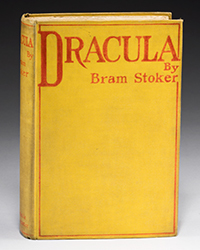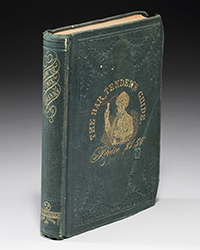By chance I encountered an unfamiliar book two years ago on the website of De Wolf & Wood Rare Books (Alfred, Maine); it was a privately printed Catalogue of the Private Library of Mr. George S. Davis, issued and dated, Detroit, August 1st, 1890.
For years I’ve been acquiring material for Rare Book Hub’s Transactions+, and I thought this volume an interesting speculation. Sometimes these purchases work out and others not. On that occasion it has. Whether Mr. Davis’s catalogue was prepared as a prequel to auction or simply intended as a tribute to a collector’s achievement, RBH provides opportunities since 2002 for such arcane-iana to show up in our searches. This volume fell into the second category: excellent descriptions and organization, but nary a hint of valuation. The listed price was $250 later discounted to $200. I set it aside.
Upon closer examination it was neither fish nor fowl. This volume was a well-executed collector’s catalogue, typeset in the style of Joseph Sabin’s Bibliotheca Americana. I then asked De Wolfe and Wood about their copy’s back story.
De Wolfe and Wood has a book shop and inventory-laden barns in Alfred, Maine. Mr. Davis’s book took the long route to geting there. Printed in 1890 in Detroit, their copy found its way to Ernest Wesson in Mansfield, Ohio, where he plied the old and rare book trade for most of forty years (1937-1972). This title did not get into his storied dealer catalogues, Midland Notes, but found a second life after he passed away in 1974 when his remaining stock was sold to his cataloguer, Mrs. Carlson, who moved the remaining stock to upstate, New York. Under her auspices Mr. Davis’s account remained in her possession on dusty shelves. And soon forgotten.
Eventually, Frank Wood bought her remaining stock and Mr. Wood and Mr. De Wolfe posted Mr. Davis’s catalogue on their website in 2022. As a potential reference source for Rare Book Hub, the listing caught my attention. Mr. Davis’s volume soon found a home with me in San Francisco.
As I started to read the Davis catalogue in early 2024, I found myself reaching for my copy of the Dictionary of American Book Collectors by Donald C. Dickinson (1986), hoping to find Mr. Davis’s collecting story; alas, no story. But he was profiled on Wikipedia: https://en.wikipedia.org/wiki/Parke-Davis
At age 21, in 1866, Davis was hired by Duffield, Parke & Co., druggists in Detroit, Michigan. Soon after, the firm was reorganized: George S. Davis become their salesman and soon after, their General Manager of what would become known worldwide as Parke, Davis & Co, a premier pharmaceutical company. Mr. Davis’s imagination and ambition would come to define the company.* https://acshist.scs.illinois.edu/bulletin_open_access/v25-1/v25-1%20p28-34.pdf
At heart, it appears Mr. Davis became an educated speculator, funding research for possible medical cures, then developing testing procedures with his partner that would become international standards for the rising generation of drug companies. In due course, the company would increase life expectancy for human beings worldwide: Parke, Davis rapidly became one of America’s most valuable companies.
By 1877, Davis and his writing partner, Dr. Charles Henri Leonard, were editing “New Preparations; A Quarterly Journal of Medicine, Devoted to The Introduction of New Therapeutical Agents.
By the 1880s, Davis was becoming a celebrity. His rising status and routine comings and goings are well documented in the clippings-and-archives morgue of the Detroit Free Press. And with success came the symbols: club memberships, a gorgeous home in the right neighborhood, and (of course) the requisite gentleman’s library that reflected cultivated tastes.
In that era, the wealthy occasionally published books about their collections: and Davis’s was quietly released on August 1st, 1890. I say quietly with care, as such volumes tend to get around to announce the author’s taste and intellectual sweep. Only two handfuls of his volume can be located in the OCLC today. Interestingly, most found shelter on the west coast, while the cognoscenti on the east, apparently have yet to notice this gaping hole in their holdings, though Harvard’s Countway Library, Boston, includes a few other Davis-related printings.
Adding mystery: While Davis was a man-about-town, living in a fine house and holding an important job, the Detroit Free Press would mention his attendance at one meeting or another, yet no mention of his book or his sizeable collection?
As to his catalogue, modeled in part on Joseph Sabin’s Bibliotheca Americana, Davis did not limit himself to Americana; borrowing from Sabin, his catalogue included titles ranging from “Adventure” to “Zoology”. And besting Sabin, his catalogue included 136 other categories. To my dimming eyes and diminishing intellect, it looks like a credible, well organized collector’s catalogue. Clearly, Davis and his research staff adopted Sabin’s Bibliotheca as their north star, producing a serious collector’s bibliography. Turning his pages now in 2024, Davis’s achievement retains the look and feel of what Sabin’s opus brought to the collecting world in the 1870s.
As to his volume’s contents, it was quite extensive: 3,277 titles and 5,060 books enumerated in its index. Two printing details were amiss, may I add. The indicia on the title page employed the expected typeface, except the year was hastily changed not matching either the font or spacing. Likewise, the introductory flattery on the PREFATORY NOTE was cut mid-sentence, leaving the first page incomplete and its verso blank going directly into careful bibliographical detail. Oh, poor dazed reader!
If this was a strategy to encourage a close reading, it worked.
As to Davis’s collection, it appears to have disappeared. In 1896, his firm acquired many of his assets including his library. But then, what did they do with them? Assuming he had a bookplate in his books, such identifiers are often remarked. The Stewart Bookplate Collection, University of Illinois-Urbana has found a bookplate matching his name, though it suspiciously looks a bit pro forma; and mind you, none of the 3,277 titles and 5,060 books listed in Catalogue of the Private Library of George S. Davis have yet been found anywhere with that bookplate.
Given that Mr. Davis was a mere 45 when he published his opus, there would be more to his story:
It was in the early 1890’s that automobile manufacturing was beginning to take hold in the Detroit area. Davis appears to have been doing well, but new fortunes were being created and others lost. He was associated with several publications relating to health and medicines into the decade.
And, of course, a bust of him by H. Wehner was crafted in marble in 1888 and apparently gifted to the Detroit Museum of Art, and subsequently lost.
He was already living in a lovely home that was included in Detroit Illustrated in 1889. And his name would continue to be mentioned in the Detroit Free Press increasingly connected with land speculation, race horses and his boat Sultana.
His celebration of his fabulous collection was short-lived. On November 14, 1896 this notice appeared in Detroit Free Press:
"Yesterday a bill of sale was filed in the city clerk’s office, dated November 10, in which Geo. S. Davis conveys a large amount of valuable property to Chas. M. Woodruff, Parke, Davis 7 Co.’s attorney, for $1 and other valuable consideration. The list enumerates the following: Marble statuary, bronzes, porcelains, glassware, bric-a-brac, etchings, framed and unframed, library, books, furniture, bedding, linen, wines, liquors, clothing and all other personal property of any character whatsoever now stored in the room in the third story of Parke, Davis & Co.’s laboratory known as the “Gymnasium,” or elsewhere; also his coach, rockaway, victoria, covered sleigh, harness and other appurtenances."
On December 19, the same newspaper confirmed that Parke, Davis bought his stock.
And in 1906, he was declared bankrupt.
During that same year, further evidence of his bibliophilic taste has been found in Rare Book Hub’s databases as the Anderson Auction Company sold a previously unknown Autograph Collection formed by George S. Davis (of Detroit) in 1906. [link accessible to signed-in paid services members].
In that same year, he retired from Parke, Davis and was awarded a pension; perhaps more importantly, the firm kept the Davis name. Apparently he also lost his home along the way, spending his later years, sadly, as a boarder.
Over the ensuing years, through the aging pages of the Detroit Free Press, his presence was still occasionally mentioned; but all mention ceased after October 1st, 1930, when George S. Davis passed on, age 85. In his final appearance in the Detroit papers, a brief notice tersely mentioned that his service was not well attended.
He married late and never had children, but Davis left various publications to posterity including his self-published Catalogue of his private library and his single owner sale with Anderson. But where are those many, many books now?
In its best of times, this was a rich, fulfilling life. I wish Mr. Davis joyful hours in the great hereafter.
A concluding note: I’ve compared his material included in his 1890 catalogue with his Anderson sale in 1910, and found them separate and distinct.
Links:
1. Link to the history of Parke, Davis
2. Citation to the Detroit Free Press archives
3. A photograph of him
4. A image of his home when he was at his peak,
5. A map of Detroit world
6. An image of the Anderson auction of his material 4/30-52 and a link to that sale
Link to the Anderson Auction in 1906 (Accessible to paid serices members)
Acknowledgements to:
Carla Reczek, Digital Specialist Librarian, on behalf of the Burton Historical Collection at the Detroit Public Library
Laura Kennedy, Archives, Detroit Public Library
Stephanie Krauss, Center for the History of Medicine, Harvard Countway Library, Boston
Curatorial Staff, John Starr Stewart Ex Libris Collection, University of Illinois-Urbana
And special thanks RBH’s friend and guest writer / researcher, collector Maureen E. Mulvihill, originally of Detroit, a valued resource in this article.





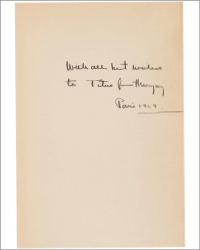







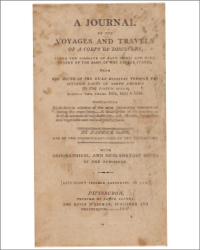


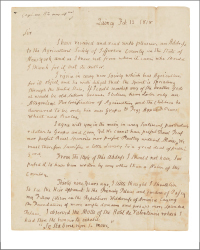

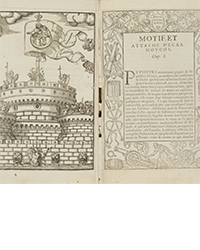
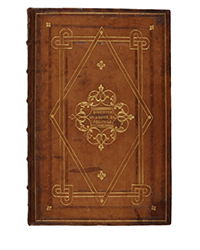
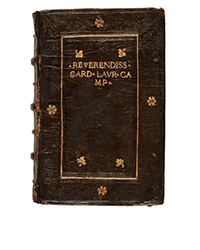
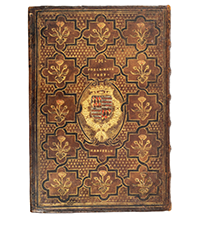
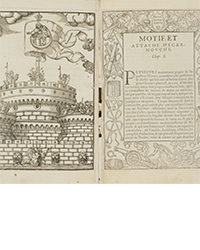

![<b>Sotheby’s, Dec. 16:</b> [Austen, Jane]. A handsome first edition of <i>Sense and Sensibility,</i> the author's first novel. $60,000 to $80,000. <b>Sotheby’s, Dec. 16:</b> [Austen, Jane]. A handsome first edition of <i>Sense and Sensibility,</i> the author's first novel. $60,000 to $80,000.](https://ae-files.s3.amazonaws.com/AdvertisementPhotos/9a74d9ff-42dd-46a1-8bb2-b636c4cec796.png)


![<b>Heritage, Dec. 15:</b> John Donne. <i>Poems, By J. D. With Elegies on the Author's Death.</i> London: M[iles]. F[lesher]. for John Marriot, 1633. <b>Heritage, Dec. 15:</b> John Donne. <i>Poems, By J. D. With Elegies on the Author's Death.</i> London: M[iles]. F[lesher]. for John Marriot, 1633.](https://ae-files.s3.amazonaws.com/AdvertisementPhotos/8caddaea-4c1f-47a7-9455-62f53af36e3f.jpg)


